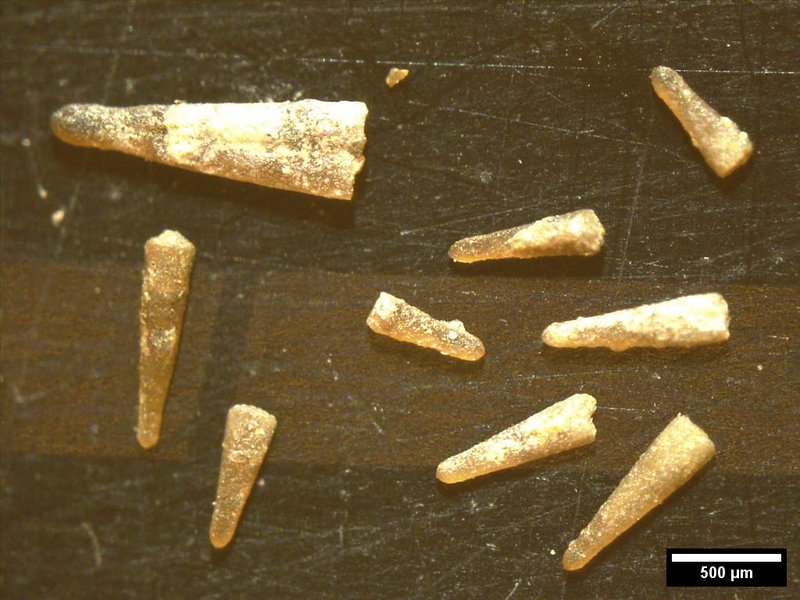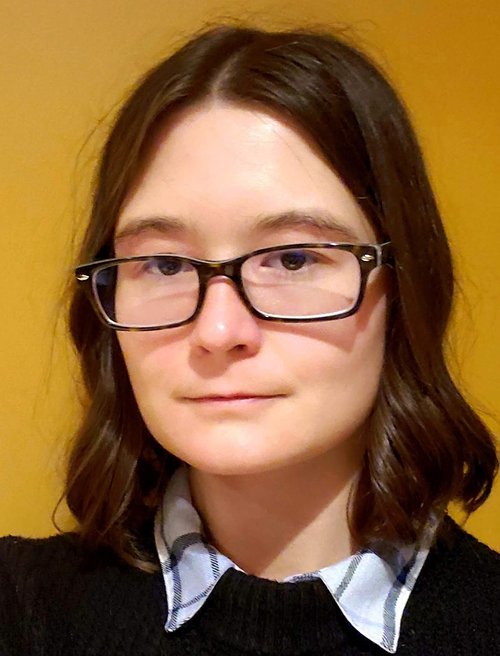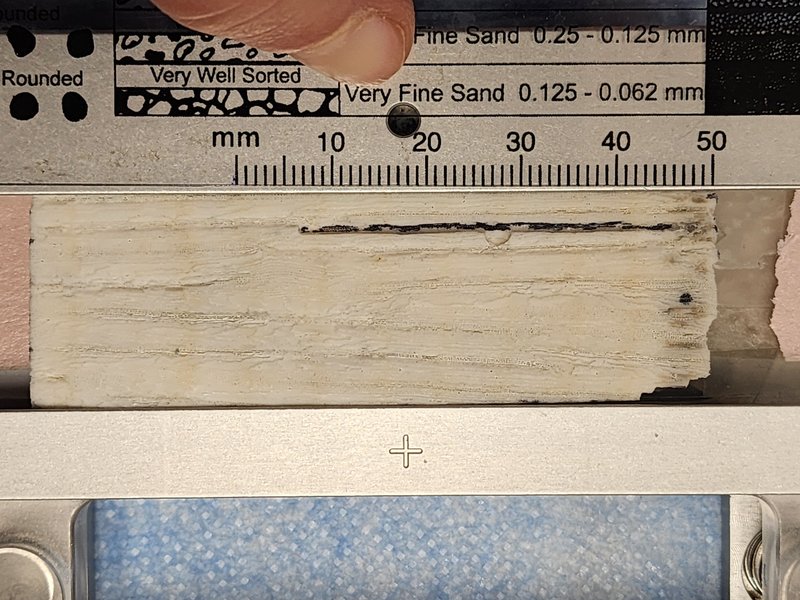Ph.D. graduate’s paleontology research may shed light on ecological and animal responses to past, future climate change.

A microscope view of Devonian-era dacryoconarid microfossils reveals a wide range of sizes. These size differences offer valuable insights for reconstructing ancient environmental conditions and forecasting how ecosystems might respond to modern climate change.
by Caroline K. Reff
One of the most critical issues facing the scientific world, no less the future of humanity, is climate change. Unlocking information to help understand and mitigate the impact of a warming planet is a complex puzzle that requires interdisciplinary input from some of the world’s greatest minds.

At Syracuse University’s College of Arts and Sciences (A&S), Ashley Prow-Fleischer (pictured) ’25 Ph.D. is taking the lead in a brand new area of paleontology that could unlock vital information towards this global effort by using the past to predict the future.
The Devonian Period took place around 400 million years ago and was a critical time in evolution when plants began to appear and four-legged creatures like amphibians emerged from the sea. Even before the dinosaurs roamed the Earth, present day New York is believed to have been located 20 degrees south of the equator with a tropical environment covered in inland seas. Scientists believe that the late Devonian Period brought on extinction events marking a significant time of environmental change, which might offer information about climate changes happening today.
Approximately 40% of the rocks found in New York today were formed during the Devonian Period, and hidden in these rocks are clues to understanding the relationship between the terrestrial and marine biospheres that created this transition, hopefully extrapolating the timing and the rate to modern environmental changes.
“Paleontology is a multidisciplinary field that combines different aspects of biology, chemistry, geology and math. However, geochemistry, which is a subdiscipline of paleontology, is my specialty,” says Prow-Fleischer.
Microfossils May Help Predict Future Changes
One aspect of Prow-Fleischer’s research concentrates on extinct marine plankton abundant in many rocks in this region. As the base of the food web, variations in the body sizes or distribution of plankton can be used to reconstruct past environmental changes on ecosystem structure and predict ecosystem response under modern day climate change.
Too small to be seen by the human eye, the plankton must go through a special process to be separated from the rock, while still maintaining its shell integrity. Unfortunately, standard techniques use corrosive and carcinogenic chemicals, but Prow-Fleischer has developed a safer and more environmentally friendly alternative. Using a method that includes soaking the rock to allow water to seep into cracks and then repeatedly freezing to create pressure in the rock and then thawing, the process weakens the rock matrix, causing it to split the cracks around the microscopic fossils.
Prow-Fleischer has also been experimenting with various surfactants (soaps) that can gently and safely remove dirt from the uncovered fossils. Interestingly, she discovered that the most effective surfactants are actually Calgon and sodium carbonate found on grocery store shelves. This method increases the rate of extraction in a way that is safer for humans, giving greater access to the information these fossils may hold.
This technique has allowed Prow-Fleischer to extract enough fossils to survey their body sizes across a warming interval in the late Devonian Period, which showed they became smaller over time. This is significant in that it demonstrates the implication for energy transfer in food webs today. If oceans warm, then plankton get smaller, negatively impacting fish stocks .
Coral Used as History Book of the Environment
Another area of her research focuses on coral, which Prow-Fleischer calls “the history book of the environment” because some can live for thousands of years. Coral grows by accretion of layers, like the rings of a tree, which tell a story of the conditions of the ambient sea water that existed around the time each was formed.

A section from a core of Siderastrea siderea, or massive starlet coral, is set inside the sample cell for analysis. Faint light-dark banding on the coral about every 10 cm displays its annual growth cycle. The black line is a previously measured section that is used to orient it in the analyzer.
This research has moved forward thanks, in part, to facility access she had at A&S to a novel iodine-to-calcium proxy developed for geochemistry by her advisor, Professor Zunli Lu, in the Department of Earth and Environmental Sciences (EES).
“The goal is to be able to apply this proxy specifically to fossilized or subfossilized corals, so we can target areas of the world that might be susceptible to oxygen depletion via climate warming, or even be able to extend reconstruction as far back as the last Ice Age, which is something I’m exploring,” she says.
She has also been able to perform her work using a laser available at the SUNY-ESF labs, which is a unique tool in her coral research.
A Passion for the Mystery of Paleontology
While Prow-Fleischer came to A&S to complete a Ph.D. in geochemistry, she quickly pivoted to paleontology, something she was always interested in but didn’t pursue until she realized the opportunities Syracuse University could give her for a viable career in this field.
Prow-Fleischer has been so devoted to her work that she published four papers before defending her dissertation, something that generally doesn’t happen. She has collaborated with others with similar interests, including Lucy Weisbeck ‘24 (SUNY-ESF) and Caroline Underwood ’23, both co-authors on “Extraction of calcareous dacryocaonarid microfossils from limestones and mudrocks by surfactants paired with freeze-thaw processing,” in Marine Microplantology, as well as her primary EES mentors, Thonis Family Associate Professor Tripti Bhattacharya and Professor Linda C. Ivany.
“Ashley is fearless in the face of a challenge, diving into the deep end even when in unfamiliar territory,” says Ivany. “She has mastered some fairly beefy coding and statistics in her time here and done the same with a powerful Earth system model that has quite a steep learning curve, all of which have been brought to bear in her research.”
After receiving a Ph.D. in May, Prow-Fleischer accepted a position as a post-doctoral researcher at the Payne Paleogeology Lab at Stanford University. Joining as a geochemist, she will work with other experts in the hopes of further exploring options to help mitigate climate warming.
“I love the mystery of paleontology and what you might discover. The work I’ve been able to achieve at the College of Arts and Sciences has been rewarding,” says Prow-Fleischer. “Overall, I plan on a career in academics where I can continue to explore the biological effects on climate change and use my curiosity and skills to contribute further to the collective betterment of society.”
